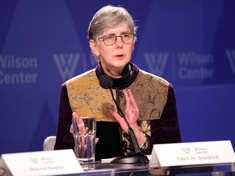-
Ellen Starbird: Sexual and Reproductive Health and Rights Undergird Success of SDGs
April 10, 2015 By Schuyler Null
“Advancing reproductive health and family planning can positively influence and advance a number of sustainable development priorities,” says Director of USAID’s Office of Population and Reproductive Health Ellen Starbird in this week’s podcast.
“Advancing reproductive health and family planning can positively influence and advance a number of sustainable development priorities,” says Director of USAID’s Office of Population and Reproductive Health Ellen Starbird in this week’s podcast.
The Sustainable Development Goals, up for adoption later this year, are meant to improve upon the Millennium Development Goals, which have guided international development for the last decade and a half. They will recognize the environment as a more integral part of global development and have goals applicable to all countries, not just the poorest.
Sexual and reproductive health and rights is not among the 17 top-level goals, but “there are really none of these SDGs that can be moved along as fast as they could be if we don’t also take this issue into account,” says Starbird.
“None of these SDGs that can be moved along as fast as they could be if we don’t also take this issue into account”There are at least 222 million women in developing countries that want to space or limit births but are not using modern contraception. “They want to control their fertility, and often lack the means, the access, the agency to do that,” says Starbird.
Making universal access – and the agency to exercise that access – a priority has significant health benefits for women and families, she says. It reduces maternal mortality and morbidity, reduces infant and child mortality, leads to fewer abortions, and contributes to lower HIV transmission.
“People can understand that you don’t want women and kids to die,” Starbird says, but there are other knock-on effects that are not as intuitive. “On the more social and economic side, the ability to choose when you’re going to have your children and how many you’re going to have allows women to stay in school, to participate in the workforce, [and] for families to spend more of their resources on the quality of their children.”
The phenomenon known as the “demographic dividend” has allowed some countries to boost economic productivity, but is not possible without lower fertility rates. And there are myriad environmental and social effects that come with lower population growth.
What’s in a Measurement?
Empowerment, not control, is the objective, Starbird says. “Underneath all that, there has to be a guiding principle around voluntarism and informed choice that puts the responsibility and the opportunity to take action in the hands of the woman and not in the hands of the state or some higher order entity.”
USAID’s proposed indicator for measuring family planning is a reflection of this focus on the individual. Starbird says the agency is proposing the SDGs measure the percentage of sexually active women of reproductive age who do not want to become pregnant, with a goal of reaching 75 percent in all countries by 2030. This is “ambitious but achievable,” she says, while keeping the focus on unmet demand and encouraging countries to satisfy that demand across wealth, age, residence, and other demographic factors.
The rate of increase in modern contraceptive users is slower than what’s needed to reach the goals of the FP2020 Initiative, a major effort by the Bill and Melinda Gates Foundation and many development agencies launched in 2012. Current projections fall 53 million users short of the initiative’s 2020 targets, Starbird says. The SDGs then are a chance to reiterate international commitment.
“Universal access to family planning is not the singular route to any of this,” Starbird says, “but without addressing family planning and population issues, the impact and effectiveness of what the other SDGs are trying to accomplish is going to be much less.”
Ellen Starbird spoke at the Wilson Center on March 18 as part the “Managing Our Planet” seminar series.
Friday Podcasts are also available for download on iTunes.
 A Publication of the Stimson Center.
A Publication of the Stimson Center.




